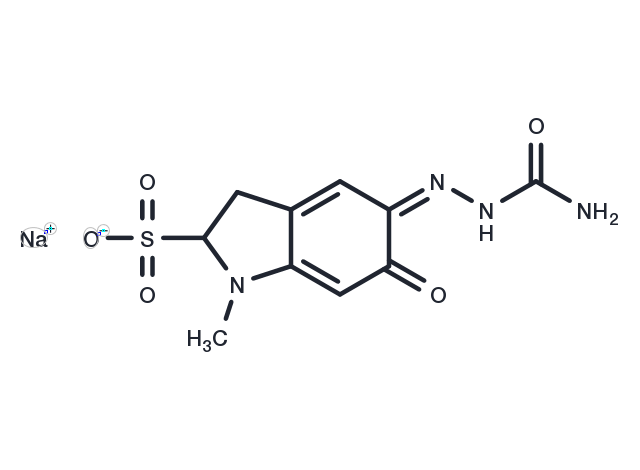Powder: -20°C for 3 years | In solvent: -80°C for 1 year


Carbazochrome sodium sulfonate (AC-17) (AC-17) is an antihemorrhagic for the treatment of hemorrhoids.

| Pack Size | Availability | Price/USD | Quantity |
|---|---|---|---|
| 25 mg | In stock | $ 30.00 | |
| 50 mg | In stock | $ 59.00 | |
| 100 mg | In stock | $ 97.00 | |
| 500 mg | In stock | $ 233.00 | |
| 1 mL * 10 mM (in DMSO) | In stock | $ 34.00 |


| Description | Carbazochrome sodium sulfonate (AC-17) (AC-17) is an antihemorrhagic for the treatment of hemorrhoids. |
| In vitro | Administering 10 mg/kg of Carbazochrome significantly inhibited the reduction of arterial oxygen levels. Additionally, at the same dosage, Carbazochrome reversed the iodocetate-induced increase in vascular permeability in rats in a dose-dependent manner. |
| In vivo | Carbazochrome at concentrations of 0.1-1 M attenuates concentration-dependent synthesis of [(3)H]myo-inositol and [(3)H]-inositol induced by bradykinin and thrombin. It also counteracts the functional impairment caused by trypsin, thrombin, and bradykinin, with ionophores like ionomycin, A23187, or phorbol 12-myristate 13-acetate enhancing this effect without affecting endothelial permeability. In human umbilical vein endothelial cells, carbazochrome significantly reduces the ratio of t-PA antigen in the culture medium without notably affecting the PAI-1 antigen ratio. It reverses trypsin-induced actin stress fiber formation and disrupts VE-cadherin in monolayers of porcine aortic endothelial cells. Additionally, in cultured bovine vascular endothelial cells, carbazochrome distinctly inhibits hyperpermeability induced by trypsin, thrombin, and protease-activated receptor 2 agonist peptides. |
| Synonyms | AC-17 |
| Molecular Weight | 376.32 |
| Formula | C10H17N4NaO8S |
| CAS No. | 51460-26-5 |
Powder: -20°C for 3 years | In solvent: -80°C for 1 year
Ethanol: < 1 mg/mL (insoluble or slightly soluble)
DMSO: 60 mg/mL (159.4 mM)
H2O: 3 mg/mL (9.3 mM)
You can also refer to dose conversion for different animals. More
bottom
Please see Inhibitor Handling Instructions for more frequently ask questions. Topics include: how to prepare stock solutions, how to store products, and cautions on cell-based assays & animal experiments, etc.
Carbazochrome sodium sulfonate 51460-26-5 GPCR/G Protein Neuroscience Adrenergic Receptor stabiliser inhibit capillary Inhibitor AC-17 AC17 antihemorrhagic AC 17 haemorrhage inhibitor
